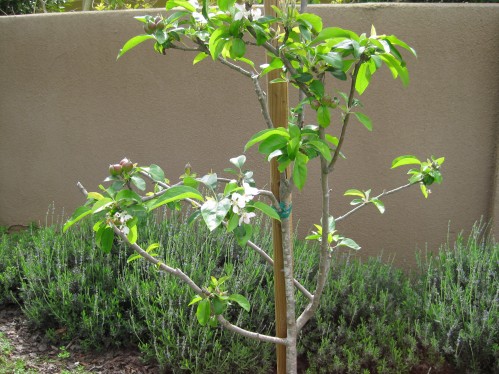Five Space-Saving Fruit Tree Techniques
 At the risk of going out on a limb, no pun intended, general trends today indicate that we have smaller spaces to garden in, converging with more desire to grow our own food. It is also the age- old adage, "less is more." Here are five space-saving fruit tree techniques to help you maximize growing your own desired fruit.
At the risk of going out on a limb, no pun intended, general trends today indicate that we have smaller spaces to garden in, converging with more desire to grow our own food. It is also the age- old adage, "less is more." Here are five space-saving fruit tree techniques to help you maximize growing your own desired fruit.
1) Espalier Fruit Trees on a two-dimensional plane in a pattern on a supporting wall, side of building, or fence. South and west facing direction are best for this. Espaliered fruit trees is one of my favorite styles as well as shapes for my fruit trees. You can either espalier them yourself, or buy them already pattern-established from a nursery or on online.
2) Multi-Variety Fruit Trees are available also from your favorite nursery. Meaning these fruit trees are already grafted and established with different varieties on one tree. I have a pear tree that has comice pear, d'anjou pear, and red bartlett pear harmoniously growing together in one tree. This winter, I got a "4 in 1", which has two types of nectarines and two types of peach. You have one tree, but multiple varieties in one tree.
3) High-Density Planting of Fruit Trees. Planting of similar or dissimilar varieties of fruit trees closely together. For instance, planting four fruit trees 18" to 24" apart in a square shape, in a 10' x 10' area. Requires summer pruning, but gives you the advantage of a possible long and varied fruit season, easy cross-pollination, natural restriction of fruit tree size, and a great appearance. With high-density planting you can create free-form shapes such as gazebos, circles, or as a hedge in a straight line. Dave Wilson Nursery calls it Backyard Orchard Culture.
4) Limit Your Fruit Tree Size. After purchasing your bare root tree and planting it in your chosen location, cut the top 1/3 of your tree off at a 45 degree angle above a bud. Further trim any side branches or shoots to 6" to encourage new growth. Limiting your fruit tree size initially when planted, will keep your fruit tree small and manageable for maintenance and harvest size.
5) Plant Fruit Trees In Containers. Fruit trees in containers are beautiful, space-saving, and practical for small areas. Use on patios, entrances, and where ever you want to make a statement. Research what fruit trees do best in containers. Citrus trees are a good choice, if you have the climate.
Please share what is your favorite fruit tree in your yard or garden? Please comment if you think about space to harvest ratio in your yard and garden?
Thank you for supporting VGG sponsors!
